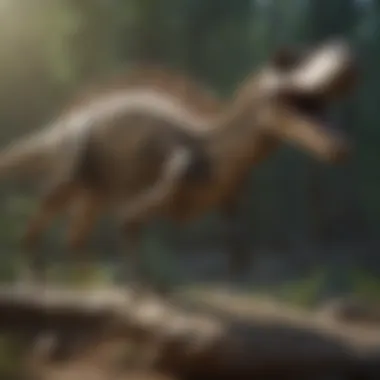Unveiling the Enigmatic Spinosaurus: Giant of the Ancient Seas


Rock and Fossil Identification
In the realm of paleontology, the identification and study of rocks and fossils play a pivotal role in unraveling the mysteries of ancient creatures like Spinosaurus. When embarking on a journey to explore the largest water dinosaur, it is essential to understand the types of rocks and fossils that may hold clues to its existence. These include sedimentary rocks that often preserve fossils with intricate detail, such as marine shale and limestone formations. Fossil characteristics to look for in the search for Spinosaurus remnants can range from skeletal fragments to teeth and even coprolites, providing valuable insights into the creature's behavior and diet. Utilizing tools like brushes, chisels, and magnifying lenses becomes imperative in delicately uncovering and examining these paleontological treasures.
Geological Insights
Delving deeper into the geological context of Spinosaurus, one must appreciate the significance of geological formations and processes in which its fossils are embedded. Understanding the historical implications of these rocks and fossils offers a glimpse into ancient environments where the massive water dinosaur once roamed. Notable discoveries within these formations have revolutionized the field of paleontology, shedding new light on the evolutionary history and ecological dynamics of prehistoric aquatic ecosystems. By examining the stratigraphy and sedimentology of the sites where Spinosaurus fossils are found, researchers can reconstruct a narrative of the past, enriching our understanding of this majestic creature's place in Earth's history.
Collecting Tips and Techniques
For enthusiasts and professionals alike, proper collecting practices are essential in preserving the integrity of Spinosaurus fossils and contributing valuable data to scientific research. Employing best practices involves meticulous fieldwork, precision tools, and adherence to ethical standards in fossil collecting. Locating prime sites where Spinosaurus remnants may be found, such as ancient riverbeds or coastal regions, requires a keen eye for geological clues and a profound knowledge of the creature's habitat preferences. Safely extracting specimens from these sites without causing damage demands expertise in excavation techniques and specimen handling. By following strict guidelines and fostering a deep respect for the delicate nature of these fossils, collectors can ensure the preservation of valuable scientific data for future generations.
Preservation and Display
Preserving Spinosaurus fossils for posterity involves a blend of scientific rigor and creative display concepts. Various techniques, including fossil consolidation and stabilization, are employed to prevent degradation and maintain the structural integrity of specimens. Proper storage methods, such as climate-controlled facilities and archival-quality packaging, safeguard these invaluable artifacts from environmental factors that could jeopardize their longevity. When it comes to displaying Spinosaurus fossils, innovative ideas that blend education and aesthetic appeal can captivate audiences and ignite a passion for paleontology. From interactive exhibits to virtual reconstructions, the possibilities for showcasing these ancient wonders are as vast as the oceans Spinosaurus once ruled with its powerful presence.
Introduction
In the vast and enthralling realm of paleontology, the titanic Spinosaurus emerges as a beacon of fascination – a colossal water dinosaur that once reigned supreme in ancient waters. This article serves as a portal to delve into the mystique surrounding Spinosaurus, offering an in-depth exploration of its unparalleled characteristics and profound evolutionary significance. Through meticulous analysis and compelling narrative, readers are invited to embark on a captivating journey through the annals of prehistoric marine life, unraveling the enigmatic secrets of this magnificent creature.
Exploring Spinosaurus Origins
Discovery of Spinosaurus Fossils
Delving into the intriguing genesis of Spinosaurus, the unearthing of its fossils stands as a pivotal moment in paleontological history. The discovery of Spinosaurus fossils has provided researchers with invaluable insights into the morphology, behavior, and ecological significance of this iconic aquatic predator. By meticulously examining fossilized remains, scientists have pieced together a comprehensive understanding of Spinosaurus' physical attributes, offering a vivid glimpse into its life history and evolutionary adaptations. The significance of the Discovery of Spinosaurus Fossils lies in its contribution to expanding our knowledge of prehistoric marine ecosystems and the biodiversity that once thrived in ancient seas. Through detailed examination and meticulous documentation, researchers have shed light on the anatomical intricacies of Spinosaurus, reshaping our perceptions of this majestic water dinosaur.
Geographical Distribution
Another compelling facet of Spinosaurus' enigmatic narrative is its geographical distribution across ancient landscapes. The study of Spinosaurus' geographical distribution provides critical clues about its habitat preferences, migratory patterns, and adaptation to diverse environmental conditions. By exploring the regions where Spinosaurus roamed millions of years ago, paleontologists have gained valuable insights into the behavioral ecology and evolutionary context of this awe-inspiring aquatic predator. The geographical distribution of Spinosaurus fossils serves as a testament to the once-domineering presence of this majestic creature in primeval waters, offering a window into a bygone era teeming with ancient wonders and formidable predators.
Significance of Spinosaurus


Ecological Role
At the heart of Spinosaurus' mystique lies its unparalleled ecological role as a top predator in prehistoric aquatic ecosystems. The ecological role of Spinosaurus encompasses its position at the apex of the food chain, shaping the dynamics of ancient marine communities and influencing the evolutionary trajectories of myriad species. By examining its interactions with other organisms and its impact on the ecosystem, researchers have unraveled the complex web of relationships that defined Spinosaurus' role in ancient waters. The significance of understanding Spinosaurus' ecological role extends beyond paleontological curiosity, shedding light on the intricate balance of power and interdependence that governed prehistoric seas.
Evolutionary Adaptations
The evolutionary adaptations of Spinosaurus stand as a testament to the creature's remarkable resilience and ability to thrive in aquatic environments. From specialized cranial features to adaptations for swimming and hunting, Spinosaurus' evolutionary journey is a testament to the forces of natural selection and the artistry of survival in ancient waters. By dissecting the anatomical peculiarities and physiological innovations of Spinosaurus, researchers have uncovered a wealth of information about its evolutionary lineage and adaptive strategies. The evolutionary adaptations of Spinosaurus offer a glimpse into the challenges and opportunities that shaped its evolutionary path, painting a vivid portrait of a species uniquely attuned to the demands of life in a marine realm.
Physical Characteristics
In the realm of paleontology, the exploration of an ancient creature's physical characteristics provides crucial insights into its existence and behavior. For the enigmatic Spinosaurus, delving into its physical attributes unravels a tapestry of evolutionary adaptations and ecological roles. One cannot overlook the significance of understanding how size, proportions, limbs, and locomotion played a pivotal role in shaping the life of this massive water dinosaur.
Size and Proportions
Comparative Analysis
When embarking on a comparative analysis of Spinosaurus, researchers unearth a treasure trove of data that sheds light on its unique stature among dinosaurs. By juxtaposing Spinosaurus's size and proportions with other aquatic and terrestrial species of its era, scientists can discern the evolutionary path that led to its colossal dimensions. This comparative spotlight not only magnifies Spinosaurus's stature but also crafts a narrative of how its size dictated its ecological niche, offering a glimpse into its predatory prowess and lifestyle. Through a meticulous examination of bone structures and fossil remnants, researchers can decipher the growth patterns and physical transformations that manifested in Spinosaurus over millennia. This comparative lens acts as a time machine, transporting enthusiasts back to an era when giants ruled the earth's waters and land.
Cranial Features
Exploring the intricacies of Spinosaurus's cranial features unveils the secrets hidden within its skull that echoed its predatory habits and sensory acuity. A holistic view of its cranial morphology hints at the hunting strategies it employed and the sensory capabilities that governed its aquatic existence. Delving into the nuances of Spinosaurus's cranial adaptations provides a gateway to understanding its feeding mechanisms, communication signals, and even potential interactions with its environment. The cranial features serve as a roadmap to deciphering the unique interplay between form and function in this magnificent water predator, offering a glimpse into a bygone era where survival of the fittest took on colossal proportions.
Limbs and Locomotion
Aquatic Adaptations
Parsing through Spinosaurus's aquatic adaptations illuminates a world where limbs evolved into tools for navigating underwater realms with unparalleled agility and grace. The specialized limb structures of this water giant speak volumes about its evolutionary journey from land-dweller to aquatic behemoth. By studying the particte environments reshaped by its presence and the behavioral cues gleaned from its limb morphology.
Swimming Abilities
Unraveling the mysteries of Spinosaurus's swimming abilities unveils a saga of unparalleled aquatic prowess honed through millennia of evolution. Its swimming capabilities transcend mere locomotion, offering a window into the complex biomechanics that powered this colossal creature through ancient waters. By dissecting the unique adaptations that facilitated Spinosaurus's aquatic feats, researchers peel back the layers of time to reveal a creature perfectly sculpted by its environment for mastery of the marine domain. The study of its swimming abilities not only enriches our understanding of prehistoric aquatic ecosystems but also underscores Spinosaurus's reign as a true titan of the deep waters.


Habitat and Behavior
In the intricate study of Spinosaurus, understanding its habitat and behavior is of paramount importance. Delving into the habitat aspects sheds light on the preferred dwelling places of this colossal water dinosaur. It offers insight into the environmental conditions Spinosaurus inhabited, providing clues about its adaptation and survival strategies. Moreover, unraveling the behavior patterns of Spinsaurus unveils details about its interaction with its surroundings and other species, painting a vivid picture of its place in the prehistoric ecosystem.
Aquatic Environment
Feeding Habits
Exploring the feeding habits of Spinosaurus is a fascinating endeavor that adds depth to our comprehension of this ancient creature. The specific aspect of feeding habits showcases the dietary preferences and hunting techniques employed by Spinosaurus. By dissecting its feeding habits, we can grasp the predatory nature and sustenance patterns crucial for its survival. The key characteristic of Spinosaurus's feeding habits lies in its piscivorous nature, signifying a preference for consuming fish in its aquatic habitat. This choice resonates as fundamentally essential for the species, considering the abundance of aquatic life forms in its dwelling, providing a reliable food source. The unique feature of Spinosaurus's feeding habits is its adaptation to an aquatic diet, showcasing specialized anatomical features tailored for effective fish predation. These adaptations conferred advantages by ensuring sustenance in its marine environment, showcasing evolutionary prowess while potentially presenting limitations in terms of adapting to alternative diets.
Social Behavior
Delving into the social behavior of Spinosaurus offers a glimpse into its communal dynamics within the prehistoric waters. Understanding the specific aspect of social behavior elucidates how Spinosaurus interacted with its counterparts, indicating potential cooperative or competitive behaviors. The key characteristic of Spinosaurus's social behavior lies in its potential for group living or solitary habits, providing insights into its social structure and interactions. This choice proves pivotal for enriching our knowledge of Spinosaurus within this article, highlighting the intricate social dynamics of this colossal water dinosaur. The unique feature of Spinosaurus's social behavior is its potential for pack hunting or solitary predation, showcasing diverse adaptation strategies for securing food resources. These behaviors may have conferred advantages in terms of increased hunting success through collaboration or independence, although accompanying disadvantages could include intra-group conflicts or resource competition.
Nesting and Reproduction
Reproductive Strategies
Examining the reproductive strategies of Spinosaurus unravels the intriguing mechanisms employed by this ancient species to ensure its continuation. The specific aspect of reproductive strategies unveils the breeding practices and evolutionary adaptations linked to the perpetuation of Spinosaurus. Highlighting the key characteristic of Spinosaurus's reproductive strategies illuminates the modes of courtship, mating, and offspring rearing observed in this species. This detailed exploration proves beneficial within the context of this article as it enhances our understanding of Spinosaurus's reproductive biology. The unique feature of Spinosaurus's reproductive strategies lies in potential display behaviors, nest construction, or parental investment, showcasing diversified approaches to reproduction. These strategies may have advantages in terms of offspring survival and species propagation, while potential disadvantages could include increased parental investment or vulnerability to environmental perturbations.
Parental Care
Unpacking the concept of parental care in Spinosaurus offers a glimpse into the nurturing habits of this colossal water dinosaur. Exploring the specific aspect of parental care unveils the caregiving practices and protective measures undertaken by Spinosaurus towards its offspring. Highlighting the key characteristic of Spinosaurus's parental care elucidates the extent of parental involvement in raising and safeguarding the young within this species. This focus proves invaluable for enriching our understanding of Spinosaurus's familial dynamics, shedding light on its nurturing behaviors. The unique feature of Spinosaurus's parental care can manifest in behaviors such as nest guarding, food provisioning, or teaching offspring survival skills, showcasing a breadth of parental strategies. These care practices may confer advantages in terms of offspring development and survival, yet may pose challenges in terms of parental energy expenditure and vulnerability to predators or environmental changes.
Controversies and Debates
In the realm of paleontology, controversies and debates surrounding Spinosaurus hold immense significance, igniting intellectual discourse and driving further investigation into the mysteries of this colossal water dinosaur. These discussions serve as a catalyst for delving deeper into the evolutionary adaptations and behavioral peculiarities of Spinosaurus, shedding light on its role in ancient ecosystems. The exploration of controversies and debates enriches our understanding of this enigmatic creature, offering compelling insights into its swimming abilities, dietary preferences, and ecological interactions.
Swimming Abilities
Evidence and Interpretations


Exploring the evidence and interpretations related to Spinosaurus' swimming abilities unveils a fascinating aspect of its evolutionary history. By analyzing the fossil record and anatomical features of Spinosaurus, researchers have pieced together a compelling narrative of its aquatic locomotion. The identification of specific skeletal adaptations, such as streamlined body structures and paddle-like limbs, provides crucial insights into Spinosaurus' prowess in navigating prehistoric waters. These interpretations not only enhance our grasp of this magnificent creature's lifestyle but also contribute significantly to the broader discourse on aquatic adaptations in dinosaurs.
Buoyancy Mechanisms
The buoyancy mechanisms associated with Spinosaurus epitomize a critical aspect of its aquatic existence. Delving into the intricacies of how this massive reptile managed buoyancy sheds light on its foraging strategies, predator avoidance techniques, and overall survival in water habitats. By examining the anatomical features related to buoyancy control, such as air sacs and bone density, scientists continue to unravel the complexities of Spinosaurus' underwater movements. Understanding these mechanisms not only underscores the evolutionary innovations of this remarkable species but also offers vital clues about the dynamics of marine ecosystems during the Mesozoic era.
Dietary Preferences
Fish vs. Land Prey
The debate surrounding Spinosaurus' dietary preferences between fish and land prey unveils intriguing facets of its feeding behavior and ecological niche. Through the analysis of fossilized stomach contents and tooth morphology, researchers have diverging viewpoints on whether Spinosaurus primarily targeted aquatic creatures or terrestrial animals. The examination of isotopic signatures and biomechanical studies adds further layers of complexity to this contentious issue, highlighting the intricate interplay between Spinosaurus and its prey choices. Dissecting the evidence for both piscivorous and carnivorous tendencies in Spinosaurus not only enriches our understanding of its trophic interactions but also underscores the challenges in reconstructing the dietary habits of ancient predators.
Dental Adaptations
The dental adaptations of Spinosaurus stand as pivotal indicators of its dietary specialization and ecological role within Mesozoic ecosystems. By scrutinizing the shape, size, and wear patterns of Spinosaurus' teeth, paleontologists glean vital clues about its preferred prey items and feeding strategies. The evolution of serrated edges, conical shapes, and crushing surfaces in Spinosaurus' dentition points to a diverse repertoire of feeding behaviors, encompassing both scavenging and active hunting. Analyzing the dental adaptations of Spinosaurus not only showcases the intricacies of its trophic adaptations but also underscores the predatory dynamics that shaped the ancient aquatic food webs.
Legacy and Impact
Spinosaurus holds a paramount position in the field of paleontology, particularly in terms of its lasting legacy and impact on our understanding of ancient marine environments. By delving into the evolving study of Spinosaurus and its significance, researchers have uncovered a myriad of insights that have reshaped our perceptions of prehistoric aquatic ecosystems. From shedding light on the behaviors and adaptations of this colossal water dinosaur to offering crucial clues about the dynamics of marine environments, Spinosaurus stands as a remarkable symbol of prehistoric evolution.
Paleontological Insights
Understanding Marine Environments
Understanding Marine Environments plays a pivotal role in unraveling the mysteries surrounding Spinosaurus. Its contribution lies in providing a comprehensive view of the unique habitats that Spinosaurus inhabited, offering a detailed understanding of the interactions between this apex predator and its marine surroundings. The key characteristic of Understanding Marine Environments is its ability to contextualize Spinosaurus within its ecosystem, thereby enhancing our grasp of the species' evolutionary adaptations. This unique feature allows researchers to reconstruct the environmental conditions that shaped Spinosaurus' evolution, providing invaluable insights into ancient marine life.
Implications for Evolutionary Studies
Exploring the Implications for Evolutionary Studies unveils a deeper layer of Spinosaurus' legacy. This aspect contributes significantly to the overarching goal of understanding the evolutionary trajectory of this iconic predator. The key characteristic of Implications for Evolutionary Studies is its capacity to link Spinosaurus' adaptations to broader evolutionary patterns, offering a glimpse into the species' phylogenetic relationships and evolutionary history. By examining the implications of Spinosaurus on evolutionary studies, researchers gain a more profound appreciation for the dinosaur's role in the evolutionary tapestry of prehistoric life.
Educational Value
Engaging the Public
The educational value of Engaging the Public lies in its ability to bridge the gap between scientific research and public fascination with Spinosaurus. This aspect contributes to enhancing scientific literacy among enthusiasts and novices alike, promoting an appreciation for paleontological discoveries. The key characteristic of Engaging the Public is its capacity to translate complex scientific concepts into accessible and engaging content, fostering a deeper connection between audiences and the world of paleontology. This unique feature enables a wider audience to appreciate the significance of Spinosaurus and its impact on our understanding of prehistoric life.
Inspiring Future Discoveries
Inspiring Future Discoveries serves as a catalyst for continued exploration and research into the realm of paleontology. This aspect propels scholars and enthusiasts alike to seek out new frontiers in understanding ancient life forms, encouraging interdisciplinary collaborations and innovative approaches to studying Spinosaurus. The key characteristic of Inspiring Future Discoveries is its potential to ignite curiosity and passion for paleontological discoveries, sparking a renaissance in scientific inquiry and exploration. By inspiring future generations of researchers, Spinosaurus leaves a lasting legacy that transcends time and sparks curiosity in the endless possibilities of uncovering ancient secrets.







